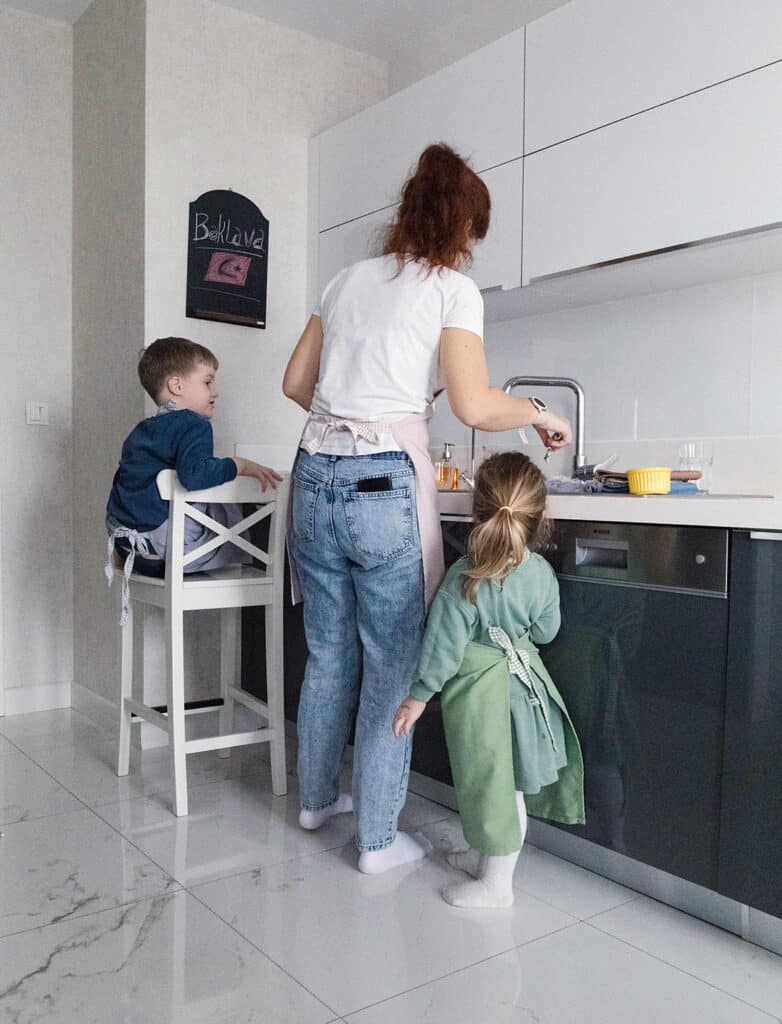
Photo by Sarah Chai

Photo by Mikhail Nilov
Being a stay-at-home mom is more than just a title; it’s a demanding role that requires juggling multiple responsibilities daily. Often underestimated, this role encompasses a range of tasks that are both challenging and rewarding.
A stay-at-home mother is the heart of her household, managing everything from child care to cooking meals. This role is a full-time job in itself, involving much more than meets the eye.
From managing household chores to potty training, a stay-at-home parent must handle an array of duties while ensuring the well-being of their children.
In this article, we’ll explore the multifaceted responsibilities of a stay-at-home mom, breaking down the major tasks involved. We’ll delve into child care and education, meal planning, daily cleaning, and more.
Discover how these responsibilities contribute to the smooth running of a household and the challenges faced by those in this role.
By grasping the complexities of the stay-at-home mom’s role, you’ll gain a new appreciation for their dedication and the real job they do.
Here are 8 key responsibilities of a stay-at-home mom:
- Child Care and Education: Oversee daily care and educational activities for children.
- Meal Planning and Preparation: Plan and cook nutritious meals for the family.
- Daily Cleaning: Keep the home clean and organized.
- Laundry and Dishwashing: Manage laundry and dishes.
- Supporting and Loving Partner: Provide emotional support to your partner.
- Finance Management: Handle household budgeting and expenses.
- Organizing Family Activities and Needs: Schedule and coordinate family activities.
- Self-Care and Personal Growth: Focus on self-care and personal development.
See also Career or Relationship: 6 Steps for Finding a Right Balance
Difficulties of Mom’s Responsibilities

Being a stay-at-home mom is a full-time job that comes with a range of difficulties. Stay-at-home parents often face the challenge of managing their time effectively while completing numerous household tasks, all while recognizing the importance of family bonding.
They are responsible for raising kids, ensuring they spend quality time with their own children, and creating a balanced routine that benefits everyone in the household.
The job description includes long hours with little rest. Many mothers find themselves working late into the night and on weekends. Whether it’s preparing dinner, cleaning, or attending to a child’s life events, the duties can feel relentless.
Home moms deal with constant multitasking and the mental load of remembering various responsibilities for their family members.
Here are 9 Difficult Duties of Stay-at-Home Moms:
- Managing household tasks – Ensuring the house is cleaned and organized regularly.
- Meal planning and preparation – Creating healthy meals for the family every day.
- Taking kids to and from school – Coordinating drop-offs and pick-ups.
- Helping with homework – Assisting children with their school assignments.
- Scheduling appointments – Organizing doctor and dentist visits.
- Budgeting – Managing household finances.
- Emotional support – Being available to listen and provide comfort.
- Errands – Grocery shopping and other necessary trips.
- Event planning – Organizing family activities and birthdays.
These duties demonstrate the extensive and varied nature of the responsibilities that stay-at-home mothers handle daily.
Here are 8 responsibilities of stay-at-home moms:
1. Child Care and Education

Child care and education are critical responsibilities for a stay-at-home mom. This involves daily tasks such as feeding, changing diapers, bathing, and ensuring the children’s well-being. For families with kids of similar ages, managing these tasks can feel like a full-time job.
Here are 10 childcare and education tips for stay-at-home moms:
- Reading Time: Incorporate daily reading sessions to foster a love for books and improve language skills.
- Educational Games: Use puzzles, board games, and apps that promote learning in a fun and engaging way.
- Arts and Crafts: Encourage creativity and fine motor skills through drawing, painting, and crafting activities.
- Outdoor Play: Promote physical health and exploration by spending time in parks, gardens, or the backyard.
- Structured Learning: Establish a routine that includes basic lessons in math, science, and literacy suited to your child’s age.
- Social Interaction: Arrange playdates or join local groups to help children develop social skills.
- Life Skills: Teach practical skills like cooking, cleaning, and personal hygiene as part of their daily routine.
- Music and Dance: Introduce music and dance to enhance cognitive development and self-expression.
- Storytelling: Share stories, whether from books or your imagination, to enhance listening skills and creativity.
- Mindfulness and Relaxation: Teach simple relaxation techniques like deep breathing and mindfulness to help manage emotions and stress.
The educational role is just as significant. Stay-at-home moms often decide to integrate learning into daily routines. This might include reading stories, practicing counting, or teaching basic skills. These activities help prepare kids for school and enhance their cognitive development.
Staying home allows parents to deeply engage with their children and address individual needs. For example, teaching two kids of similar age can be more streamlined and tailored. Also, being at home provides the flexibility to manage household duties like laundry while ensuring children receive consistent care and attention.
Child care and education within the home do not just cover the basics; they offer an opportunity for parents to instill values, routines, and habits. This investment in children’s early years holds a significant, though not always monetary, value for their future development.
2. Meal Planning and Preparation

Meal planning and preparation are significant duties for stay-at-home moms. They often anticipate the family’s needs by planning meals weeks or months in advance. This approach helps in staying organized and ensuring that nutritious meals are on the table regularly.
One useful strategy is to create a master list of meal ideas. This list can be rotated and modified based on the family’s preferences and seasonal ingredients. Including the family in the meal planning process can sometimes reduce the burden on the mom and make meals more enjoyable.
Grocery shopping is another key component of meal planning. Making a list of all the ingredients needed for the week helps stay-at-home moms stay focused and efficient during shopping trips. This practice minimizes the number of trips to the store and ensures that everything necessary for the meals is available.
Cooking is a daily task that demands time and energy. Stay-at-home moms often act as the family’s private chef, preparing breakfast, lunch, and dinner. On weekends, they might plan more elaborate meals when there’s more time available.
Additionally, cleaning up after meals is an integral part of the process. It maintains the hygiene and organization of the kitchen, ensuring a well-managed household.
By effectively managing meal planning and preparation, stay-at-home moms play a crucial role in the family’s wellness and daily routine.
3. Daily Cleaning

Daily cleaning for a stay-at-home mom involves managing various areas of the household to maintain cleanliness and order. Responsibilities include tasks in different parts of the home such as the bedroom, bathroom, and kitchen. Managing these daily chores ensures a tidy living environment for the whole family.
Tasks like changing diapers and picking up children’s toys are routine parts of household management. A clean kitchen involves washing dishes, wiping counters, and sweeping floors. The job description also includes straightening up the bedroom by making beds and putting away laundry.
Examples of Daily Cleaning Options:
- Wiping Down Surfaces: Involves cleaning countertops in the kitchen and bathroom, ensuring they are free from germs.
- Vacuuming Carpets and Rugs: Keeps the living areas free of dust and debris, promoting a healthy indoor environment.
- Dish Duty: Placing dishes after every meal helps maintain a clean and tidy kitchen space.
- Toy Pickup: Collecting and organizing children’s toys prevents clutter and increases safety around the home.
- Bathroom Cleaning: Includes wiping down sinks, cleaning toilets, and ensuring the bathroom remains sanitary for all family members.
By following these daily cleaning tasks, stay-at-home mothers can effectively manage a balanced and orderly home, creating a pleasant living space for their families.
See also Weekly Chores List: 8 Steps to a Cleaner and Healthier Home
4. Laundry and Dishwashing

Laundry and dishwashing are crucial tasks for any stay-at-home mom. These responsibilities ensure that the household functions smoothly, making life easier for everyone, especially in larger families.
Laundry involves washing, drying, folding, and organizing clothing for the entire family. With children, this task becomes even more significant. Clothes must be sorted by color and fabric type, ensuring nothing gets damaged.
A stay-at-home mom might spend several hours each week just on laundry. This includes using the right detergents and stain removers, particularly for active little ones who often soil their clothes more frequently.
Dishwashing is another essential daily task. After breakfast, lunch, and dinner, dishes must be cleaned to maintain a hygienic home environment. This can be done by hand or using a dishwasher, depending on the household setup.
Creating a routine for these tasks helps manage them efficiently. Incorporating teaching moments, such as having chores for teenagers, folding laundry, or loading the dishwasher, can also instill responsibility and teamwork in young ones.
Balancing laundry and dishwashing with other responsibilities like taking care of school schedules, preparing meals, and cleaning the rest of the house requires effective time management.
A stay-at-home mom must decide on the best strategies to keep up with these tasks while ensuring the household runs smoothly and everyone’s needs are met.
5. Supporting and Loving Partner

A stay-at-home mom manages numerous tasks daily. To ensure she feels valued and appreciated, her partner’s support is crucial. This collaborative effort can significantly enhance her well-being, making parenting more effective and enjoyable.
Here are 10 activities for partners:
- Home Improvement Projects: Collaborate on DIY projects to improve your living space and bond over shared goals.
- Cooking Together: Collaborate in the kitchen to create delicious meals and enjoy quality time.
- Going for Walks: Take leisurely strolls in your neighborhood or local park to relax and connect.
- Movie Nights: Choose your favorite films or new releases for cozy evenings at home.
- Traveling: Explore new places and create lasting memories together through shared adventures.
- Taking a Dance Class: Learn new dance moves and enjoy physical closeness and fun.
- Hiking: Discover scenic trails and experience nature while staying active.
- Gardening: Plant and nurture a garden, creating a beautiful space to enjoy together.
- Attending Concerts or Events: Share your love for music and entertainment by attending live performances.
- Exercise Routines: Stay fit and motivated by working out together, whether at the gym or at home.
Partners can create a nurturing and supportive environment by actively participating in these activities. This collaborative approach not only eases the daily challenges of a stay-at-home mom but also strengthens the family bond and love.
6. Finance Management

Managing the family’s finances is a crucial part of a stay-at-home mom’s responsibilities. They often oversee budgeting and ensure the household operates within its means. Successful money management skills require planning and discipline.
Many stay-at-home moms utilize money management books to improve their financial skills. These resources offer strategies for saving, investing, and planning for the future.
Creating and maintaining a budget helps track income and expenses. Using apps or spreadsheets can simplify this process. This ensures that essential household tasks and needs are prioritized.
- Budgeting: Allocate funds for food, utilities, and emergency savings.
- Savings: Regularly set aside money for long-term goals.
- Investments: Consider low-risk investments for future stability.
It’s important for home moms to involve their partners in financial discussions. This collaborative approach ensures that both are aligned on financial goals and decisions.
Teaching children about finance can also be part of the child’s life education. Simple activities like saving for a toy or budgeting their allowance can instill valuable money management skills from an early age.
7. Organizing Family Activities and Needs

Organizing family activities and addressing family needs are central responsibilities for stay-at-home moms. Utilizing life planning tools can help streamline these tasks, ensuring that each family member’s needs are met, while also creating opportunities for family bonding activities.
5 Family Bonding Activities with Kids:
- Reading Time: Share stories or read books aloud to spark imagination and promote literacy.
- Game Nights: Play board games or card games to foster teamwork and laughter.
- Outdoor Adventures: Go hiking, biking, or have a picnic to enjoy nature and physical activity.
- Cooking and Baking Together: Involve kids in preparing meals or baking to teach skills and create memories.
- Arts and Crafts: Engage in creative projects like painting, drawing, or DIY crafts for fun and self-expression.
Here are 5 family needs:
- Emotional Support: Providing love, understanding, and encouragement to create a nurturing environment.
- Financial Stability: Ensuring a stable income to meet basic needs like food, shelter, and education.
- Health and Wellness: Access to medical care, nutritious food, and opportunities for physical activity.
- Quality Time: Spending meaningful time together to strengthen relationships and foster a sense of belonging.
- Education and Growth: Encouraging learning and personal development for all family members.
8. Self-Care and Personal Growth

Self-care and personal growth are essential for stay-at-home moms. Balancing family and personal needs can be overwhelming, making it crucial to prioritize mental and physical well-being.
Utilizing tools like a self-care planner helps in scheduling regular “me time.” Regular self-care ensures moms can maintain their energy and positivity.
Incorporating practices like deep meditation and shower meditation can have profound impacts. Deep meditation helps clear the mind, while shower meditation utilizes the calming effects of water to reduce stress. These practices contribute significantly to emotional balance.
Personal growth is equally important. Engaging in personal growth challenges encourages continuous learning and self-improvement. This keeps moms motivated and connected to their individual goals and aspirations.
Here are some self-care options for stay-at-home moms:
- Pampering: Treat yourself to a spa day at home with a warm bath, skincare routine, or a DIY massage.
- Exercise: Engage in regular physical activities like yoga, walking, or home workouts to stay fit and energized.
- Hobbies: Dedicate time to personal interests such as reading, crafting, or gardening to relax and unwind.
- Quiet Time: Spend a few moments each day in quiet reflection, prayer, or simply enjoying a peaceful cup of tea.
- Social Time: Connect with friends or join local groups to build a support network and enjoy social interactions.
See also Self-Love Habits: 10 Practices for Your Inner Strength and Contentment
Stay at Home Mom Responsibilities: A Recap
Stay-at-home moms have a multitude of responsibilities that cover various aspects of life planning. They spend numerous hours taking care of their children, which includes feeding, bathing, and taking them to school or extracurricular activities. Teaching basic life skills is also a key part.
This role often involves managing tasks such as cleaning, laundry, and grocery shopping. Planning and preparing meals for the family, especially dinner, is a daily activity.
Many stay-at-home parents also handle financial responsibilities, such as paying bills and budgeting household expenses.
Despite the busy schedule, it’s important for stay at home moms to find time for personal care and rest, which is essential for maintaining their wellness. They also attend to various other tasks, including scheduling and attending appointments, planning events, and managing the overall household operations.
Balancing all these duties demands excellent time management skills.


